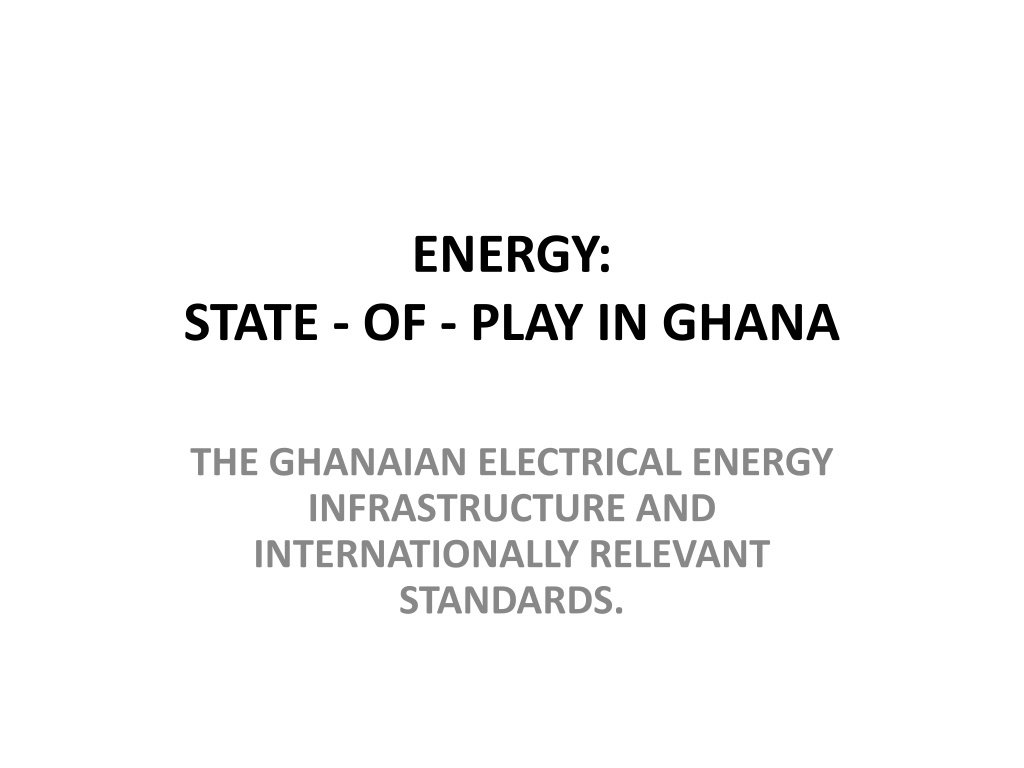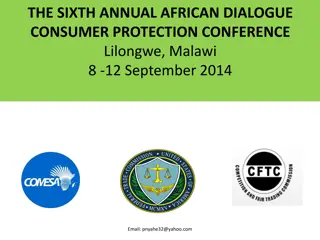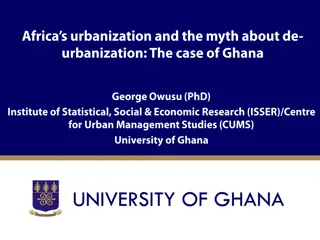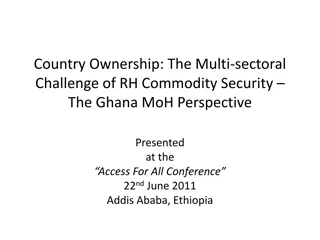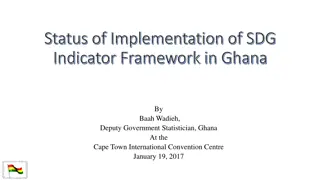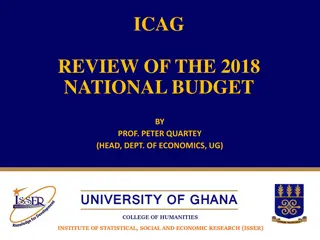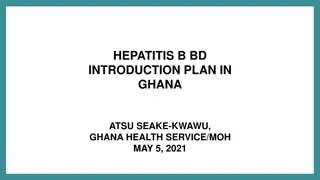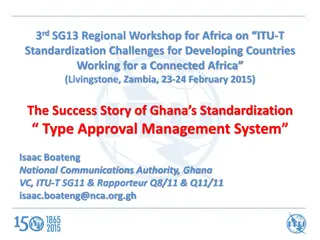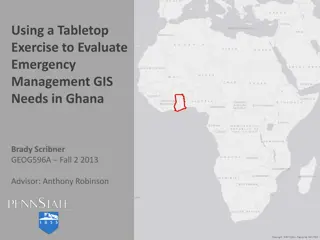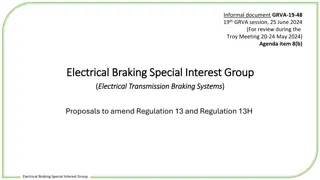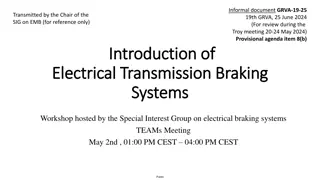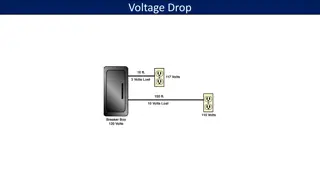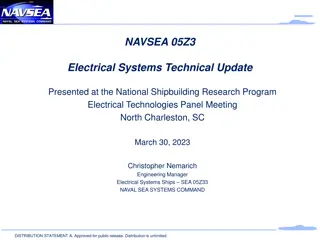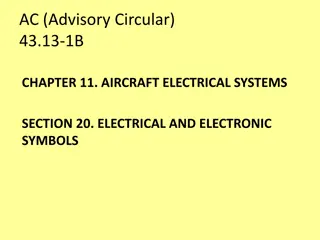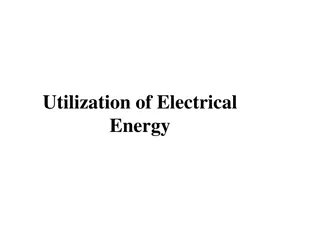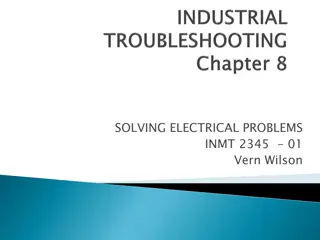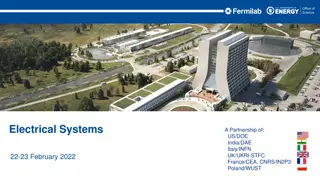Evolution of Electrical Infrastructure in Ghana
The historical development of Ghana's electrical energy infrastructure, initiated by the British government before Ghana's independence, led to the establishment of voltage standards and systems primarily based on fossil fuel generators. The Volta River Hydroelectric Project played a pivotal role in introducing renewable energy sources to support industries like aluminum production. This evolution also involved the adoption of international standards, such as ANSI, IEEE, ASTM, and ASCE, for building power plants and expanding the national grid to connect various regions. Notable voltage configurations, training initiatives, and the significance of projects like the VRA Akosombo further illustrate the progression of Ghana's electrical energy landscape.
Download Presentation

Please find below an Image/Link to download the presentation.
The content on the website is provided AS IS for your information and personal use only. It may not be sold, licensed, or shared on other websites without obtaining consent from the author. Download presentation by click this link. If you encounter any issues during the download, it is possible that the publisher has removed the file from their server.
E N D
Presentation Transcript
ENERGY: STATE - OF - PLAY IN GHANA THE GHANAIAN ELECTRICAL ENERGY INFRASTRUCTURE AND INTERNATIONALLY RELEVANT STANDARDS.
HISTORY Historically the Ghanaian Electrical Energy Infrastructure was put in place by the British government before attainment of Political Independence by Ghana. The electrical distribution system was developed for the various major cities and towns starting with Cape Coast and Accra. The system was developed according to the existing British Standards at the time. The generation was based on fossil fuel driven diesel generators.
It is interesting to note that the primary distribution Voltages were 33kV and 11kV and the utilisation voltages at residential, commercial and industrial installations was 415V AC 3- phase /240V AC - 1 phase.
VOLTA RIVER HYRO ELECTRIC PROJECT The existence of Hydro, electric energy resources has been in existence during this period. The need to develop renewable hydro - electric power was identified in relation to the development of the Aluminium industry as Ghana has bauxite resources in kibi, Nyinahin etc. Therefore the Volta River Hydro electric project was developed in consonant with the building of an Aluminium Smelter by Kaiser Engineers (Valco).
The total Ghana load at the time of development of the Volta River project (900MW) was just 95 MW. Therefore the only justification for the VRA Akosombo project was the building of 300 - 375 MW Valco Aluminium Smelter project. The source of funding of the project required the employment of the American Consultants, namely, Kaiser Engineers. It is therefore interesting to note that ANSI, IEEE,ASTM, ASCE etc standards were applied mainly for the building and commissioning of the plant and the development of a national grid to connect the various towns and cities in southern Ghana covering among others the gold mining towns.
Subsequently the national grid Voltage was selected as 161kV and the bulk supply station voltages were fixed at 34.5 kV and 11.5kV all American standard voltages, with the primary distribution voltages of 34.5kV and 11.5kV connecting the various existing distribution networks at 33kV and 11kV. It is interesting to note that a primary distribution voltage of 6.6kV was provided for the major gold mining distribution system in Obuasi.
Initially, British technical staff trained the local staff in the operation and maintenance of the distribution supply system installed before the inception of the Volta River project. Technical support for the operation and maintenance of the Volta River project was provided by Ontario hydro under a CIDA grant to Ghana.
In the late 60s , Ghanaian technical staff took over the complete operation and maintenance of the Akosombo generating station and the associated grid.
STANDARDS IN THE ELECTRICITY INDUSTRY International guidelines FIDIC for the supply and installation of electro mechanical equipment for the Akosombo project and the construction of the civil aspects of the project ,
STANDARDS IN THE ELECTRICITY INDUSTRY were employed at all times to guide the procurement, installation and commissioning of subsequent expansion of the Ghana electricity supply, transmission and distribution systems.
STANDARDS IN THE ELECTRICITY INDUSTRY International guidelines FIDIC for the supply and installation of electro mechanical equipment for the Akosombo project and the construction of the civil aspects of the project ,were employed at all times to guide the procurement, installation and commissioning of subsequent expansion of the Ghana electricity supply, transmission and distribution systems.
It is worthy to note that the need for standardization in Ghana led to the establishment of the Ghana standards authority in the early 70s. The GSA is a member of the ISO and the ITU . It works with the IEC through the Ghana National Electro technical Committee (GNEC) established in 2008. Ghana became an Affiliate member of the IEC in the early 2000 with the sole purpose of identifying relevant IEC standards for adoption and subsequent use in the electrical/ electronic industry in
Ghana. Other standards like ANSI, ASTM, ASCE,IEEE ETC have been adopted by the GSA. The need for Ghana to adopt standards by ISO, IEC and ITU was recognised because of the WTO recommendations to members to adopt international standards where national standards do not exist to avoid the erection of technical barriers to international trade.
In the area of efficiency of some electrical/electronic equipment, the Energy Commission (national regulator) has developed Efficiency labelling for window air conditioners ,CFL, Refrigerators and Deep freezers with the
aim of reducing the generation of CO2a cause of global warming. In the development of efficiency labelling IEC standards were employed, especially those covering the design and testing of the specific equipment.
CONCLUSION To conclude, Ghana through the GSA and GNEC have adopted relevant IEC standards for power transformers , substation automation etc for the generation, transmission and distribution of electrical energy and also various ISO and IEC standards for domestic and commercial appliances.
CONCLUSION The energy commission using IEC standards has also developed wiring regulations for residential and commercial installations and technical regulations for the distribution companies in Ghana. The utilization voltage in Ghana is in accordance with the IEC voltage standards of 400/ 230V AC has also been fixed by the Energy Commission.
